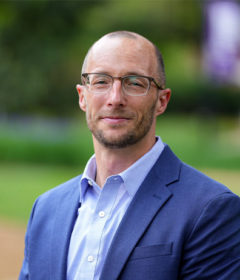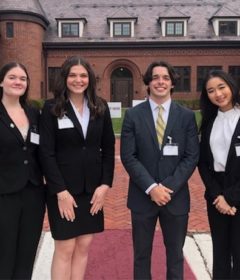‘The Treasured Photo’
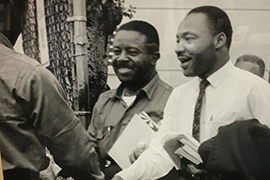
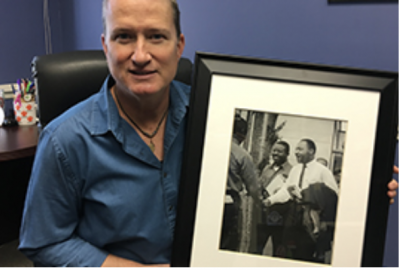
In the photo, Dr. Martin Luther King Jr. has just been released from jail in Birmingham, Alabama. It’s 1963 and beside him stands his friend, Rev. Ralph Abernathy, another key figure in the Civil Rights Movement.
Two other central figures in the struggle for equal rights are there, too, although their faces aren’t visible in the photo. King is shaking hands with Rev. Fred Shuttlesworth, the Birmingham minister who invited King to organize protests there in the spring of 1963. And taking the photo is Chris McNair, the civil-rights-era photographer whose 11-year-old daughter, Denise, would be murdered five months later in the Ku Klux Klan bombing of the Sixteenth Street Baptist Church.
The photo hung in McNair’s Birmingham gallery in honor of his daughter — until five years ago when he gave it to Bob Bickel, a Stetson Law Professor Emeritus, in appreciation of the trips that Bickel organized each summer to take Stetson Law students and undergraduates on the trail of the Civil Rights Movement.
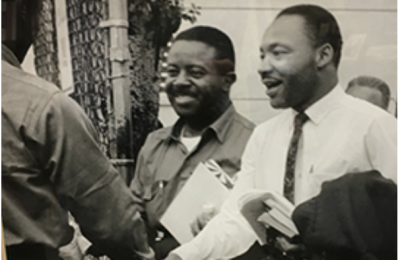
When Bickel retired last fall, he gave the photo to Stetson Associate Professor of Religious Studies, Gregory Sapp, Ph.D., who has taken undergraduate students on the trip for the past eight years. On the trip, Sapp teaches the students about the “Letter From a Birmingham Jail,” which King wrote while in solitary confinement and which retired Law Professor Bickel calls “the greatest Letter ever written during the Civil Rights Movement.”
As the nation remembers Martin Luther King on Monday, Bickel and Sapp say the photo captures a crucial moment in history because in the spring of 1963 Birmingham would prove to be the watershed in the Civil Rights Movement.
In a note with the photo, dated Oct. 5, 2016, Professor Bickel wrote: “I give to Dr. Greg Sapp the treasured photo given to me of this special moment in time, as a permanent reminder of his place in my life and the life of each of our students. He understands more than any scholar I know, that within Dr. King’s Letter lies the moral spirit of the ongoing protest of unjust law.”
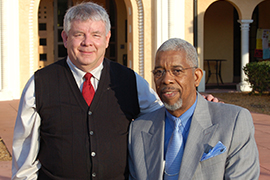
Bickel recalled that when the photo was given to him, he thought it should have gone to Sapp. “That picture, though given to me, in my heart must be his,” he said in a phone interview.
Sapp explained that King wrote the “Letter from a Birmingham Jail” in response to six white ministers who’d had a letter published in the local newspaper, criticizing King as an outsider and saying he should let the locals handle racial issues in their own way.
King was then 34 years old, very well read, eloquent and a good thinker, Sapp said. The Letter cites some of the greatest thinkers of the time – Jewish philosopher Martin Buber and American theologian Reinhold Niebuhr.
King, of course, was well educated. He enrolled at Morehouse College in Atlanta at age 15 after skipping the ninth and eleventh grades, according to Biography.com. After receiving his bachelor’s degree, he attended Crozer Theological Seminary in Pennsylvania and was valedictorian of his class. He went on to earn his doctorate from Boston University at age 26.
In the Letter, Sapp said, “King rebuts their points and says he’s not an outsider. He was invited, but also he said no U.S. citizen should ever feel like an outsider anywhere in the United States — just powerful stuff.”
The Letter is often quoted, including: “Injustice anywhere is a threat to justice everywhere” and “one has a moral responsibility to disobey unjust laws.”
King had gone to Birmingham in April 1963 after getting arrested for peaceful demonstrations in the small town of Albany, Georgia. From Birmingham, Rev. Shuttlesworth reached out to him and said if King wanted to change America’s heart and overcome racial segregation, he needed to protest in a big city, like Birmingham, Bickel said.
If King could overcome segregation in deeply-segregated Birmingham, Shuttlesworth told King, he could create racial equality throughout the South.
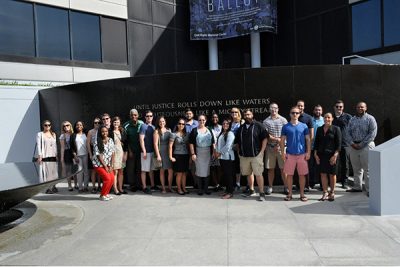
In Birmingham, local police chief, Eugene “Bull” Connor, turned water cannons, high-pressure fire hoses and attack dogs loose on thousands of nonviolent protesters, including children. The images shocked people around the world and showed the brutal oppression suffered by African-Americans in the South, Bickel said.
The lessons of that era continue to resonate today for the approximately 20 Stetson Law students who take “Constitutional Law and the Civil Rights Movement” class and visit places like Memphis, Montgomery, Selma, Birmingham and Atlanta each summer, said Tammy Briant, an adjunct professor at the Stetson College of Law who assumed the course in anticipation of Bickel’s retirement.
For example, students left for the trip in June 2015, just days after a white gunman killed nine people in a historic black church in Charleston, South Carolina, she said.
“There’s a connectivity between the trip and today’s civil rights activism,” said Briant, also Assistant Dean for Student Affairs/Deputy Title IX Coordinator for the Stetson College of Law. “We take lessons of the Civil Rights Movement and apply them to civil rights issues, such as disability and LGBT (Lesbian, Gay, Bisexual and Transgender) and immigration.”
For Sapp, the summer trips and the 1963 photo remind him of all that’s been accomplished in the past 50 years but how much remains to be done. The photo, he said, will be a prized possession “until I retire and then I’ll have to find someone to pass it on down to.”
-Cory Lancaster

